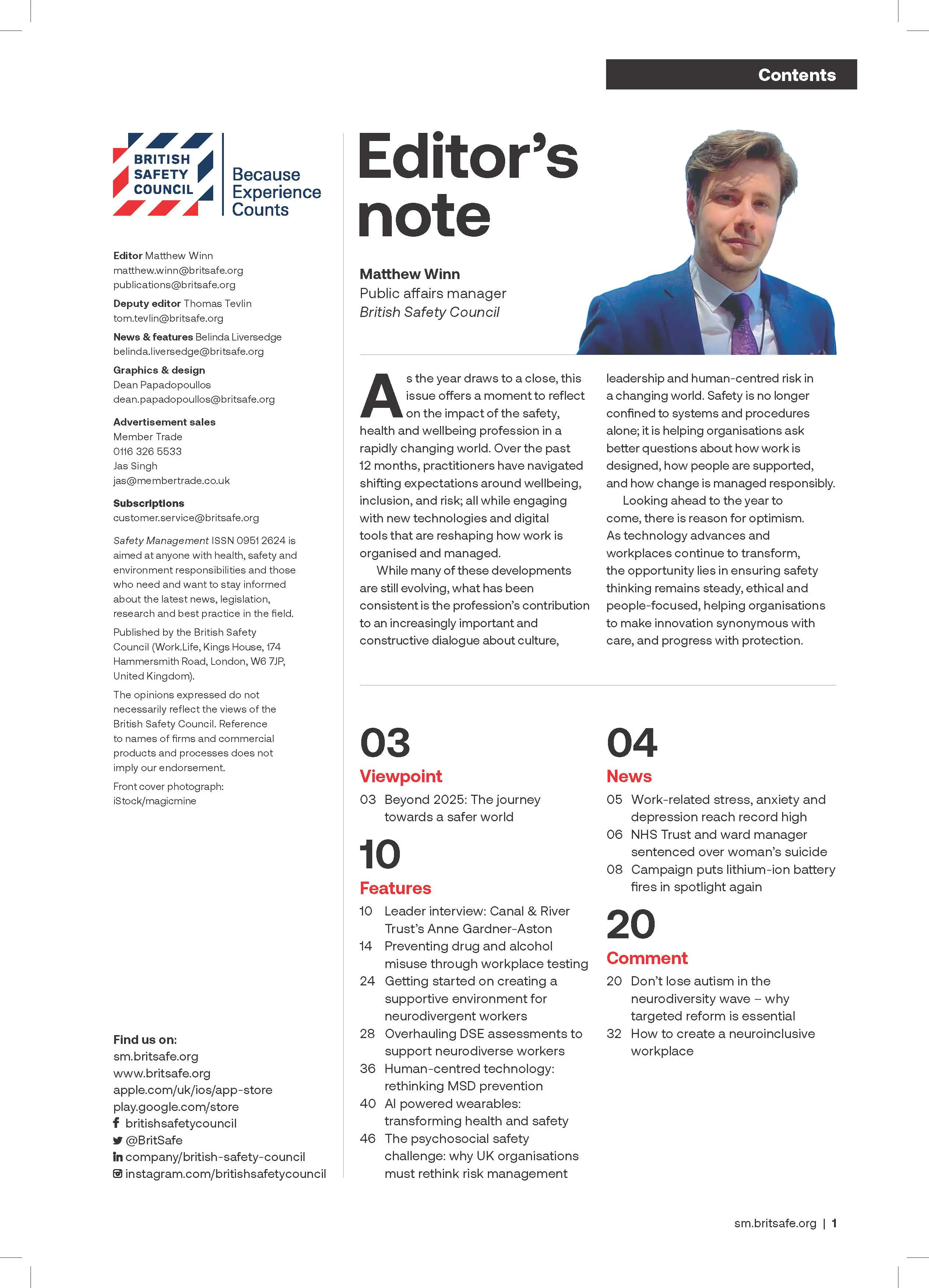Today’s workers increasingly value the flexibility to pick the most suitable working model for their needs – whether this be hybrid, fully remote or site-based. However, new BSI research shows a more important consideration is working for an organisation that genuinely prioritises employee wellbeing, offers development opportunities and encourages staff autonomy.
Opinion
Rethinking workplace wellbeing for a new era
When Covid-19 disrupted life and work across the globe, many predicted it was the beginning of the end for the traditional office. Remote work quickly became the norm for millions, particularly for those in desk-based roles who discovered they could be productive from anywhere with a Wi-Fi connection. For a time, it felt like we might never return to long commutes, shared workspaces and staff canteens.
More than five years later, the reality is more nuanced. While remote work has cemented its place in many industries, the predicted wholesale abandonment of the office hasn’t materialised. Instead, we’ve entered a more complex phase – one in which hybrid models, flexibility and employee wellbeing are central to how organisations are rethinking work.
This transformation is being shaped by the growing role of what BSI calls the Hybrid Generation – those who began their careers during or just after the pandemic. Some, in sectors or roles where this was possible, never learnt to work on-site. Many of them forged their professional identities amid uncertainty and change, and as a result, they bring new expectations to the world of work. They are not categorically anti-office, nor are they blindly pro-remote. Instead, they are advocating for something more meaningful: work that aligns with their personal needs, ambitions and wellbeing. Ultimately, this can be good not just for them but for their organisations too.
 Kate Field: "Workplace wellbeing is not just a matter of personal health – it has significant implications for national productivity and economic sustainability."
Kate Field: "Workplace wellbeing is not just a matter of personal health – it has significant implications for national productivity and economic sustainability."
A new generation with new expectations
According to BSI’s 2025 Global Workforce Entrants Study, preferences among early-career professionals vary widely. While hybrid working is the most popular model (chosen by 37 per cent of respondents), a significant 27 per cent want to work fully on-site, and 20 per cent prefer to be primarily on-site. Only 16 per cent express a desire to work fully remotely.
This challenges the idea that one model can suit all. It underscores the need for flexibility not as a perk, but as a strategic tool to unlock the full potential of the workforce. People have different needs and thrive in different environments – something that forward-thinking organisations must recognise and accommodate.
Hybrid work as a bridge to inclusion
Where hybrid or remote work models are viable, they can be seen as a gateway to greater inclusion and opportunity. Many individuals face real barriers to traditional work arrangements – barriers that include geographic limitations, the high cost of living near major employment hubs, long commutes, caregiving responsibilities or chronic physical and mental health conditions.
For example, one young professional in BSI’s focus groups shared how she was able to take a job based in London while living in Bristol – a move that would not have been financially feasible without remote work. Others emphasised the importance of home-based work environments in managing sensory overload related to neurodiversity.
These stories illustrate a broader truth: hybrid models expand access to work. They enable participation by people who might otherwise be locked out due to inflexible schedules or rigid expectations of physical presence. This is especially relevant as the UK government and others around the world seek to reduce economic inactivity and encourage re-entry into the workforce. But this cannot be achieved through mandates alone; it requires redesigning work to meet people where they are.
Workplace wellbeing is not just a matter of personal health – it has significant implications for national productivity and economic sustainability. In 2023, UK businesses lost an estimated £32.7 billion due to sickness-related absences, a number that has risen steadily from £24.6 billion in 2021 and £30.7 billion in 2022. If this trend goes on, losses could exceed £66 billion by 2030.
The root causes are complex, but can include chronic illness, stress and mental health conditions – all of which may be worsened by rigid or unsupportive work environments. Flexibility has emerged as a key tool for reducing this burden. Workers in hybrid roles consistently report better mental health outcomes: in our research 57 per cent said hybrid work enhanced their wellbeing, and among those currently working hybrid, that number rose to 70 per cent. Many cited the extra time for exercise, reduced stress and greater control over their schedule as key benefits.
However, it’s important to acknowledge that hybrid work doesn’t work for everyone. Around 34 per cent of respondents said their mental health suffered during remote work in the pandemic, and 24 per cent of current hybrid or remote workers say social anxiety would influence their decision to return to an on-site role. These insights show that flexibility must be tailored, not uniform. The goal should be giving individuals autonomy to choose the structure in which they can thrive – rather than prescribing one approach for all.
 What keeps people engaged isn’t rigid office attendance – it’s culture, alignment of values and development opportunities. Photograph: iStock
What keeps people engaged isn’t rigid office attendance – it’s culture, alignment of values and development opportunities. Photograph: iStock
Culture and connection in a hybrid age
One persistent concern about hybrid work is the potential erosion of workplace culture and collaboration. Yet BSI’s research indicates that young professionals still value in-person connection – they simply want it to be purposeful. Sixty per cent believe hybrid jobs should include designated ‘anchor days’ where teams meet in person. These opportunities allow for informal learning, mentorship and social bonding – elements that are often harder to replicate through screens.
Far from being disengaged, today’s workforce entrants show a strong sense of loyalty: 62 per cent say they feel loyal to their current employer, and over half expect to stay in their role for the foreseeable future. However, they are also pragmatic. A full 52 per cent expect to change careers during their working life, and 50 per cent believe that shift will happen in the next 10 years.
What keeps them engaged isn’t rigid office attendance – it’s culture, alignment of values and development opportunities. They want to work in organisations that prioritise wellbeing, offer growth pathways and foster trust.
Creating this kind of environment doesn’t depend on location. It depends on leadership. Effective line managers, equipped with the skills to support hybrid and remote teams, play a pivotal role in sustaining morale, providing autonomy and ensuring everyone feels included. The key for employers is to invest in upskilling their managers to build the kind of supportive environments that fuel long-term performance.
Workspaces that work for people
If companies ask people to return on-site, they must be transparent about why. There must be a clear value proposition for being present – one that goes beyond surveillance or tradition. Offices can evolve into connection hubs, designed for creativity, collaboration and community. At the same time, organisations must factor in practical issues like commuting costs, accessibility and space utilisation.
Ultimately, culture must be portable. Whether an employee is based in a factory, on a construction site, or working from their home office or a café down the road, they should feel part of a cohesive and inclusive organisation. Culture isn’t built from ping pong tables or proximity – it’s built from trust, purpose and inclusion.
A future built on flexibility and trust
While some organisations are focused on return to the office, overall the data suggests we are not going back to 2020. Nor should we want to. The past five years have offered critical lessons on what makes work – and workers – thrive. The next era of workplace wellbeing will not be defined by a single model or policy. It will be defined by adaptive thinking, inclusive practices and a people-first approach.
Hybrid models are not a panacea, but when implemented thoughtfully, they can unlock talent, support wellbeing and increase productivity. They offer organisations a powerful tool to access a broader talent pool – including individuals who may have previously been excluded by rigid or outdated ways of working.
Whether an employee is working condensed hours, split shifts, fully on-site or remotely, what matters most is that they are supported, trusted and empowered to contribute in a way that aligns with their needs and aspirations.
The Hybrid Generation is ready to work hard and contribute meaningfully, as are those who came before them. It’s now up to employers to meet their employees of all ages with systems and cultures that reflect the reality of modern life. The reward? A healthier, more resilient and more engaged workforce – one that’s built not just to survive, but to thrive.
BSI’s Hybrid Generation report can be found here
Kate Field is Global head of human and social sustainability at BSI
Kate Field will be speaking at SHW Live London Olympia on Wednesday 18 June on ‘The hybrid generation: rethinking workplace wellbeing for a new era’. See: safetyhealthwellbeing.live
OPINION

How to create a neuroinclusive workplace
By John Robinson, Schofield Sweeney on 09 December 2025
The modern workplace is a diverse environment. Most workforces will be made up of individuals representing the majority of the groups protected under the Equality Act 2010.

Don’t lose autism in the neurodiversity wave – why targeted reform is essential
By Rt Hon Sir Robert Buckland KBE KC on 03 December 2025
Autistic adults have waited too long for meaningful reform. They have shared their experiences and expertise. Now they deserve action, accountability, and transformation.

Inclusion saves lives: embedding equality, diversity and inclusion (EDI) into global occupational safety and health
By Umer Changaiz, CMIOSH on 03 December 2025



